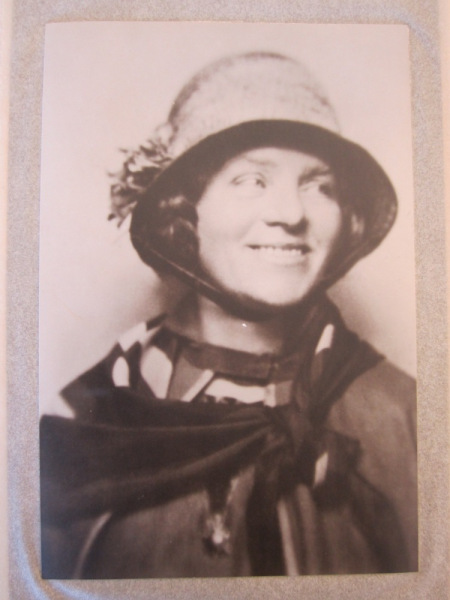Although Scottish artist, designer and teacher Jessie M. King (1875-1949) is probably most celebrated for her delicate and often whimsical illustrative work, this short article will focus on her clothing designs and dissemination of knowledge via her how-to-publication How Cinderella went to the Ball (1924).
The daughter of Church of Scotland minister, Revd James Waters King, Jessie Marion King was born on the 20 March 1875 at the manse, New Kilpatrick, Dunbartonshire. From 1892 until 1899 she attended The Glasgow School of Art (GSA) when the school, under the Directorship of Fra Newbery, was becoming recognised internationally for the ‘Glasgow Style’. This was an exciting time to attend GSA which boasted a cohort of fine artists and designers. King’s fellow students included Annie French, Ann Macbeth, Katherine Cameron, Frances and Margaret Macdonald and King’s best friend Helen Paxton Brown. During her studies she met furniture designer, artist and her future husband E.A Taylor whom she married after a ten year engagement in 1908. She stayed on at GSA from 1899 until 1907 she taught book design and illustration.
The researcher Jude Burkhauser notes that from the early 1900s King began to experiment with ‘a wax resistant technique then new to Britain’ know as batik. The technique, which originated from Indonesia, first began to gain popularity in the UK around the turn of the nineteenth century and Burkhauser states that King was exposed to the technique via the American artist Frank Zimmerer when she was in Paris.
A review of How Cinderella Was Able to Go to the Ball in 1924 by The Edinburgh Evening News commented that:
The term crops up occasionally in fashion notes, but usually with that vague allusiveness that assumes that everybody knows all there is to be known about it. But everybody does not know, and that is why ‘How Cinderella went to the Ball’ …..must be welcomed.
It is evident from the article that the term ‘batik’ was not a common phrase, or widely known technique in Scotland in 1920s. But with King’s help this would change. Batik, in its simplest definition, is a dye resistant technique using wax to create a pattern and the artist, designer and mentor King championed the technique throughout her life via her clothes and designing and printing of soft furnishings. For example, The University of Glasgow Special Collections currently holds a photograph (Photo A56/87) of a batik curtain designed by King which depicts her whimsical and magical mix of fairy like creatures and animals frolicking in a forest.
By the 1920s, King was a very experienced artist, teacher and impressive self-promoter via her carefully styled outfits. She was the perfect walking billboard to promote the technique, depicting it on an array of brightly coloured accessories, tunics and dresses. Throughout her life King made a statement about her art via herself styled and hand-crafted pieces of clothing which she designed, embroidered or printed. In many of her existing portraits, which span over her lifetime, she is often depicted wearing clothing of her own design (Fig.2).
How Cinderella Was Able to Go to the Ball was a practical step-by-step guide for anyone desiring to learn the process of batik. Apart from depicting various garments via black-and-white photographs of opera cloaks, lampshades and colourful designs for tunics (Fig.3) and dresses, King helpfully illustrated the equipment required to undertake the process.
With hand illustrations, she lists the ‘requirements for success in batik’ including beeswax, paraffin stove, small pan, pins, wax tape, brushes, ‘daily news’, a can of petrol and ‘patience, rubber gloves and a sense of design.’ The paraffin stove, bowl of beeswax and brushes can all be seen in the photograph of King and E.A Taylor in her Kirkcudbright Studio c.1936 (Fig.1) which is part of the National Galleries of Scotland, Print Room collection.
The designs, photographs and instructions are beautifully and skilfully punctuated with King’s imaginative fairy tale depictions of Cinderella at various stages of the batik process to create her ball outfit (Fig.5). By embedding the instructions in a story-like narrative, King created an accessible form of knowledge exchange and added a sense of fun to the learning process. This is apparent from book reviews of the text from the period. Remarking on the ‘ease’ and sense of creative freedom of the medium the Bystander remarked that:
What a waste of Batikless years! Ah to be an art student once again and let your colour run into smart spots, not because it was born that way but because you mean it! To-morrow I intend to start in with the beeswax, the dyes, etc. and hope for the best with regard to the patience and the sense of design.
In conclusion, this short article has only touched upon King’s wearable art and her love for batik. However, it shows that King used the technique to create her own distinctive, self-fashioned wearable art and through her publications she created an accessible format to transmit and share her knowledge of the skill.
Words: Karen Mailley-Watt
Biography: Karen Mailley-Watt received her MLitt in Decorative Arts and Design History from the University of Glasgow in 2009. She is a Scottish Graduate School of Arts and Humanities ARCS funded PhD Researcher at the University of Glasgow and the Glasgow School of Art and is currently the Gallery Coordinator for The Royal Glasgow Institute of the Fine Arts.

